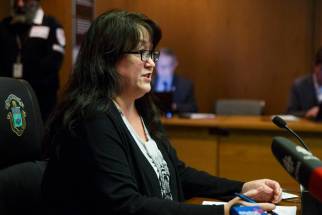Front of the class, back of the line Omicron’s assault leaves weary, fearful teachers feeling exposed as province largely ignores concerns
Read this article for free:
or
Already have an account? Log in here »
To continue reading, please subscribe:
Monthly Digital Subscription
$0 for the first 4 weeks*
- Enjoy unlimited reading on winnipegfreepress.com
- Read the E-Edition, our digital replica newspaper
- Access News Break, our award-winning app
- Play interactive puzzles
*No charge for 4 weeks then price increases to the regular rate of $19.00 plus GST every four weeks. Offer available to new and qualified returning subscribers only. Cancel any time.
Monthly Digital Subscription
$4.75/week*
- Enjoy unlimited reading on winnipegfreepress.com
- Read the E-Edition, our digital replica newspaper
- Access News Break, our award-winning app
- Play interactive puzzles
*Billed as $19 plus GST every four weeks. Cancel any time.
To continue reading, please subscribe:
Add Free Press access to your Brandon Sun subscription for only an additional
$1 for the first 4 weeks*
*Your next subscription payment will increase by $1.00 and you will be charged $16.99 plus GST for four weeks. After four weeks, your payment will increase to $23.99 plus GST every four weeks.
Read unlimited articles for free today:
or
Already have an account? Log in here »
Hey there, time traveller!
This article was published 21/01/2022 (1418 days ago), so information in it may no longer be current.
Manitoba teachers want a recess from stress.
Much like their neighbours and colleagues elsewhere on the front line, educators were hopeful COVID-19 vaccines would suddenly put an end to the novel coronavirus pandemic and the classroom disruptions that have been constant since March 2020.
In the lead-up to Labour Day, leaders boasted school operations would be “near normal” in 2021-22.
Physical distancing was eased and face coverings made optional in the summer. Remote learning was being offered strictly to students with medical exemptions. The approval of child-sized vaccine doses was imminent.
That period of optimism was long before the Omicron variant.
“Everything that’s happening feels like two steps forward, one step back — or one step forward, two steps back,” said Ashli Hodgert, a teacher who resumed face-to-face instruction in Winnipeg this week. “I feel like (the virus) is just kicking us every time we get up.”
“I feel like (the virus) is just kicking us every time we get up.” – Teacher Ashli Hodgert
The new variant is propelling a record-breaking fourth wave forward with its highly transmissible nature and ability to breakthrough vaccine immunity, although booster shots are proving to be an effective layer of protection (on top of two initial doses).
Citing the defence of vaccines and importance of in-person learning for student well-being, Manitoba announced K-12 classes would be in-person starting Jan. 17, following an extended winter break and emergency remote learning stint.
Many teachers expressed trepidation about returning to work without N95 masks, ample rapid test supplies or ongoing exposure letters issued by schools. Hundreds of students echoed their concerns and walked out of schools in simultaneous protests across the province on Jan. 17.
What is it like to be in a Manitoba school during a rising pandemic wave, with no more courtesy case notices and fewer restrictions in place than previous waves?
The Free Press posed that question to three public school teachers.
Gail Glanfield, junior high math teacher in northern Manitoba
The only thing different in Gail Glanfield’s classroom to address the rampant spread of Omicron is her comfort level.
“What actually changed in my building? Nothing — it’s horrifying to say,” she said, noting she does not have room for even one metre of space between student desks.
Glanfield likens the fourth wave containment plan to a battlefield scenario, with the province’s perspective being there are “acceptable losses,” including death, long COVID (or post-COVID condition) cases, and the inability for some to get the medical care they require.
“Teachers are the boots on the ground. We’re the front line. Us, health-care workers, daycare, police, EMS. We’re all sitting there going, ‘OK, so you’ve put the target on my back. You’ve put us out there and you’ve given us pop guns when the other side has nuclear weapons. Thanks,’” she said.
”We’re all sitting there going, ‘OK, so you’ve put the target on my back. You’ve put us out there and you’ve given us pop guns when the other side has nuclear weapons. Thanks.'” – Gail Glanfield
A member of her school’s workplace health and safety committee in 2020-21, Glanfield measured hallways, set bathroom capacity limits, and relayed public health protocols to colleagues. The math teacher became well-versed in the adjustments required to accommodate various response levels on the province’s scale, ranging from code green to red.
“This has got to be my most difficult teaching year, ever… because the rules keep changing,” said the educator of 17 years.
The Manitoba education department updated its code definitions in December, before announcing classrooms, previously in a hue of yellow, would enter a restricted level once again.
Code orange required two metres of spacing between students last year and, as a result, divisions condensed class sizes, hired more staff members and reorganized building space — at times, resulting in alternating- or half-day in-person learning schedules. The new iteration requires schools keep all students doing in-class learning full-time, which makes appropriate spacing impossible in many crowded classrooms.
“Everything I know about effective teaching methods is out the window because I have to maintain as much distance as possible.” – Gail Glanfield
Glanfield, who has an underlying health condition, has been double-masking. She has received her booster dose and requested N95s from her division for extra protection.
She recently stopped approaching student desks to answer questions and work through problems one-on-one with her portable whiteboard to limit contacts.
“Everything I know about effective teaching methods is out the window because I have to maintain as much distance as possible,” the junior high teacher added.
Reliable internet and electronic device access complicate effective e-learning in the North, but a burgeoning outbreak in Glanfield’s community has her wondering why classes have resumed in-person, both for her students and her 15-year-old son.
On Wednesday, only 30 per cent of her Grade 7, 8 and 9 students showed up to class. In her view, given a local substitute pool is non-existent, it is only a matter of time until educational assistants — if they are not also all in quarantine — will be asked to cover for self-isolating teachers.
Kathy Heppner, high school science teacher in southern Manitoba
Neither Kathy Heppner nor any of her colleagues signed up to be public health enforcement officers. The secondary job simply comes with the territory of teaching at this time.
“(Teenagers) are really sick and tired of the rules, and I’m constantly reminding them: ‘Your mask goes over your nose,’” Heppner said.
A science educator in southern Manitoba, she has witnessed firsthand the tensions that have existed in school between the vaccinated and unvaccinated and those who believe in public health restrictions versus those who are opposed. Some students have been sent home, after repeated insubordination.

Heppner said what is noteworthy about the latest wave, however, is widespread numbness.
“It feels like there’s been lost hope. Some of the kids who aren’t being as diligent with public health orders, it’s not like they’re being defiant. I think they just feel like, ‘We know we’re going to get sick, there’s nothing we can do about it, it’s just a matter of time,’” she said.
It’s demoralizing to be a teacher when students are incredibly tired and unable to actively participate in class, she said, noting public concern about learning loss is an added “kick in the teeth” to educators working tirelessly to lesson-plan during a crisis.
The biology teacher’s approach has been making space for candid conversations, reminding students they can reach out for support, and being gracious with workloads and deadlines. She is keeping Microsoft Teams open on her computer at work, in case a student messages her privately to ask her if they can take a mental health-related break.
“It feels like there’s been lost hope.” – Kathy Heppner
The virtual classroom platform has become a go-to resource for Heppner. She posts all of her notes and assignments electronically and answers questions from students who are self-isolating, after she finishes dinner on weeknights.
“It feels like a bit of a revolving door, that I’m always going to have kids that are not going to be in-class because they’re going to be calling in sick,” she said.
Heppner, a mother of four, consistently works 10 hours daily.
Ashli Hodgert, specialized teacher working with students with intellectual disabilities in Winnipeg
Ashli Hodgert lined up outside the Nairn Avenue COVID-19 testing site after a school day this week, worried a sudden wave of exhaustion could be more than just that.
Unable to access rapid tests for symptomatic, fully-vaccinated front-line staff through work yet, and confused about seemingly ever-changing PCR eligibility rules, Hodgert picked up a pack of rapid tests and drove home.
“I consider myself fairly informed, but I no longer understand what the system is,” she wrote via text.
(Education staff can get a PCR test at a Fast Pass site, if they first test positive on an at-home test. Rapid kits are available for unvaccinated staff for routine testing through work and will soon be distributed to divisions so immunized staff can obtain them if they begin to feel ill.)
“I consider myself fairly informed, but I no longer understand what the system is.” – Ashli Hodgert
Two negative results to date have provided some relief to the teacher, who had to call-in sick at the end of this week due to what has developed into “a manageable head cold.”
Throughout the pandemic, Hodgert has been working as a specialized high school teacher who works with students with intellectual disabilities, and parenting two young children — the eldest of whom only recently became eligible to get the vaccine.
In order to manage the ongoing stressors linked to both of those roles, as well as worries about her personal health, she knits. “I knit obsessively. I can probably measure the waves of pandemic and stress in knitting projects,” she said.
In recent weeks, Hodgert has produced two rag-knit sweaters from leftover yarn scraps, a black-and-cream bubble sleeve sweater, and a crew-neck vest.
“My students like to laugh at me, because I try to bring some levity into the classroom by showing them my projects. They call me a big nerd,” she said, over lunch-hour on a recent school day.
“It’s hard to continue to ask more of (students) and to go back and forward. It’s confusing and it’s frustrating for them.” – Ashli Hodgert
When classes resumed this week, the Winnipeg teacher said she was overjoyed to show her students the new addition to their classroom: a portable HEPA filter provided by her division. Her students have since named the device after a character in one of their favourite video games.
“It’s hard to continue to ask more of (students) and to go back and forward. It’s confusing and it’s frustrating for them — and I feel bad when I have to ask them to do things like eat lunch in a certain space and not be able to see some of their friends. It feels punitive. I can see the toll that it’s taking,” she said, adding she worries about the limited adult programs available to her students who are transitioning out of school this year.
Mounting anxiety prompted Hodgert to request counselling services through her union.
“Teachers are struggling, just like everyone,” she added. “We’re all doing our best.”
maggie.macintosh@freepress.mb.ca
Twitter: @macintoshmaggie

Maggie Macintosh reports on education for the Winnipeg Free Press. Funding for the Free Press education reporter comes from the Government of Canada through the Local Journalism Initiative.
Our newsroom depends on a growing audience of readers to power our journalism. If you are not a paid reader, please consider becoming a subscriber.
Our newsroom depends on its audience of readers to power our journalism. Thank you for your support.









